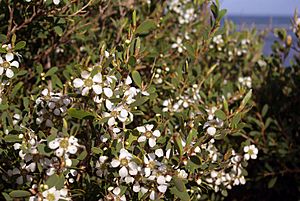Coast teatree facts for kids
Quick facts for kids Coast teatree |
|
|---|---|
 |
|
| Scientific classification | |
| Genus: |
Leptospermum
|
| Species: |
laevigatum
|
 |
|
| Occurrence data from AVH, including introductions in other states | |
| Synonyms | |
|
|
The Coast Teatree, also known as Leptospermum laevigatum, is a type of shrub or small tree. It naturally grows only in south-eastern Australia. However, it has been planted in many other places around the world. In some of these places, it is even considered a weed. This plant has thin, rough bark on its older branches. It has narrow, egg-shaped leaves and pretty white flowers. Its fruit is flat-topped and falls off soon after it ripens.
Contents
What Does the Coast Teatree Look Like?
The Coast Teatree is a bushy shrub or small tree. It usually grows to be about 1.5 to 6 meters (5 to 20 feet) tall. Older parts of the plant have thin, rough bark. The younger stems are covered with soft, silky hairs. They also have a small groove near the base of the leaf stalk.
Leaves and Flowers
The leaves are a greyish-green color. They are shaped like a narrow egg, with the thinner end at the bottom. Each leaf is about 15 to 30 millimeters (0.6 to 1.2 inches) long. They are also about 5 to 10 millimeters (0.2 to 0.4 inches) wide. The leaves grow on a short stalk.
The flowers grow on short side branches. They often appear in pairs. Each flower is usually 15 to 20 millimeters (0.6 to 0.8 inches) wide. Many reddish-brown leaf-like structures, called bracts, surround the flower buds. Most of these fall off when the flower opens.
The base of the flower, called the floral cup, is mostly smooth. It is about 3 to 4 millimeters (0.12 to 0.16 inches) long. The sepals, which are small leaf-like parts that protect the bud, are triangular. They are about 2 millimeters (0.08 inches) long. The petals are white and measure 5 to 8 millimeters (0.2 to 0.3 inches) long. The stamens, which produce pollen, are 1.5 to 2.5 millimeters (0.06 to 0.1 inches) long.
Flowering and Fruit
Coast Teatrees mainly bloom from August to October. After flowering, they produce a fruit called a capsule. This capsule is about 7 to 8 millimeters (0.28 to 0.31 inches) wide. The remains of the sepals stay attached to the fruit at first. Most of these fruits fall off the plant shortly after they become ripe.
How Did It Get Its Name?
This teatree was first officially described in 1788. A scientist named Joseph Gaertner gave it the name Fabricia laevigata. He wrote about it in his book De Fructibus et Seminibus Plantarum. Later, in 1858, another scientist named Ferdinand von Mueller changed its name. He renamed it Leptospermum laevigatum.
Meaning of the Name
The second part of its scientific name, laevigatum, comes from a Latin word. This Latin word means "made smooth" or "having a polished surface."
Where Does the Coast Teatree Grow?
The Coast Teatree is native to certain parts of Australia. It naturally grows in New South Wales, Victoria, and Tasmania. You can find it in areas with heath plants, sometimes in forests, and often on coastal sand dunes and cliffs. Its natural range stretches from Nambucca Heads in New South Wales down to Anglesea in Victoria. It also grows in northern Tasmania.
Introduced to Other Places
This plant has also been brought to other places. It is now found in Queensland, South Australia, and Western Australia. It has also been introduced to countries overseas. These include southern Africa, New Zealand, Hawaii, and the Central Coast of California.
Why Is It Important?
The Coast Teatree is very tough and can handle salty conditions. Because of this, it is often planted in gardens and along coastlines. It has also been planted in Western Australia, where it has become a weed. This means it grows too easily and can take over native plants.
Uses and Spread
In the United States, especially along the Central Coast of California, it is known as the Australian tea tree. It was planted there to help hold sand in place. Its seeds can be carried by wind and water, which helps it spread to new areas.
It has now started growing on its own in places like New Zealand, southern Africa, California, and Hawaii.
Interestingly, the tiny larvae of a moth called Holocola thalassinana like to feed on the Coast Teatree.
How Is It Used by People?
L. laevigatum is widely planted in gardens. People use it as an ornamental plant or a display tree. It is very useful for creating windbreaks, which protect areas from strong winds. It can also be used as a hedging plant.
It is great for quickly stabilizing sandy soils. This makes it helpful in areas where construction or mining has taken place. It helps to bring life back to these disturbed lands.
Is It Protected?
The Coast Teatree is not currently listed as a rare or threatened plant in Victoria (as of 2014). This means it is not considered to be in danger of disappearing in that region.
Gallery
See also
 In Spanish: Leptospermum laevigatum para niños
In Spanish: Leptospermum laevigatum para niños




